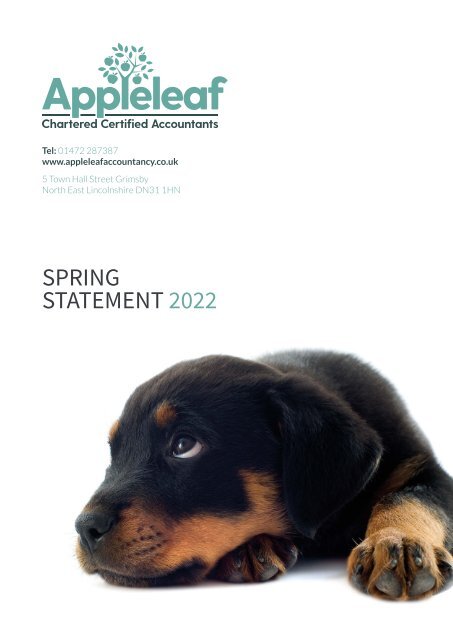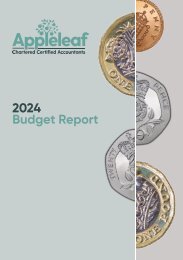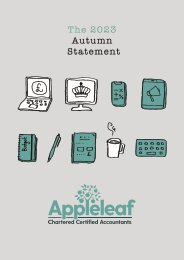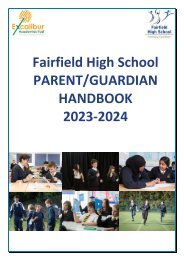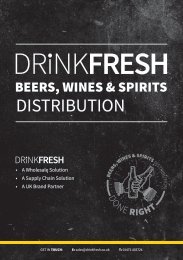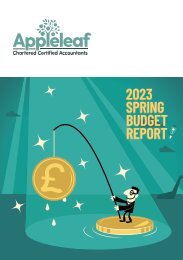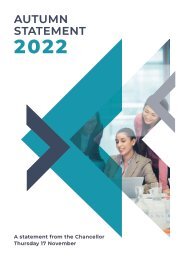Spring Statement 2022
In his Spring Statement, the Chancellor announced a cut in fuel duty for petrol and diesel as he sought to ease the impact of rising prices for households and businesses.
In his Spring Statement, the Chancellor announced a cut in fuel duty for petrol and diesel as he sought to ease the
impact of rising prices for households and businesses.
- No tags were found...
Create successful ePaper yourself
Turn your PDF publications into a flip-book with our unique Google optimized e-Paper software.
Tel: 01472 287387<br />
www.appleleafaccountancy.co.uk<br />
5 Town Hall Street Grimsby<br />
North East Lincolnshire DN31 1HN<br />
SPRING<br />
STATEMENT <strong>2022</strong>
SPRING STATEMENT <strong>2022</strong><br />
Against a backdrop of rising inflation, Chancellor Rishi Sunak presented his<br />
first <strong>Spring</strong> <strong>Statement</strong> on Wednesday 23 March <strong>2022</strong>.<br />
In his <strong>Spring</strong> <strong>Statement</strong>, the Chancellor announced a cut in fuel duty for petrol and diesel as he sought to ease the<br />
impact of rising prices for households and businesses.<br />
The Chancellor will lift the starting thresholds for National Insurance contributions (NICs). He also pledged a cut to<br />
income tax in 2024. However, the Health and Social Care Levy will still be implemented in April <strong>2022</strong>.<br />
For businesses, there is an increase to the Employment Allowance, as well as relief from business rates on a range of<br />
green technologies and help with training and the adoption of digital technology.<br />
You should contact us before taking any action as a result of the contents of this summary.<br />
HIGHLIGHTS<br />
Increase in the National Insurance<br />
threshold and Lower Profit Limit<br />
Chancellor Rishi Sunak announced an increase in the annual National<br />
Insurance Primary Threshold and the Lower Profits Limit in his <strong>2022</strong><br />
<strong>Spring</strong> <strong>Statement</strong>.<br />
Primary Class 1 contributions are paid by employees. To align<br />
the starting thresholds for income tax and National Insurance<br />
contributions (NICs) the threshold will increase from 6 July <strong>2022</strong> from<br />
£9,880 to £12,570.<br />
transitional provision in readiness for the introduction of the Health<br />
and Social Care Levy from April 2023.<br />
With the increase to the thresholds announced in the <strong>Spring</strong><br />
<strong>Statement</strong>, from 6 July <strong>2022</strong> employees earning between £242 (£190<br />
from 6 April to 5 July <strong>2022</strong>) and £967 per week will pay NICs at 13.25%.<br />
Earnings over £967 will attract a 3.25% charge. Employers will pay<br />
15.05% on their employees’ earnings over £175 per week.<br />
Although employees’ NICs only become payable once earnings exceed<br />
£242 per week, any earnings between £123 and £242 per week protect<br />
an entitlement to basic state retirement benefits without incurring a<br />
liability to NICs.<br />
For the self-employed, where their profits exceed £11,908 per annum,<br />
they will pay 10.25% on the profits up to £50,270 and 3.25% on profits<br />
over that upper profits limit.<br />
Income tax reduction<br />
The Lower Profits Limit is the point where the profits of the selfemployed<br />
become subject to Class 4 NICs. From 6 April <strong>2022</strong> the<br />
Lower Profits Limit is increased to £11,908 and from 6 April 2023 the<br />
limit is increased further to £12,570.<br />
In addition, there will be no Class 2 NICs on profits between £6,725<br />
and £11,908. £3.15 per week is payable where profits are over £11,908.<br />
Temporary increase in National Insurance<br />
rates<br />
From April <strong>2022</strong>, there will be a temporary increase in the rates of<br />
NICs payable for employees, employers and the self-employed as a<br />
The Chancellor announced the reduction in the basic rate of income<br />
tax for non-savings, non-dividend income for taxpayers in England,<br />
Wales and Northern Ireland to 19% from April 2024. This reduction<br />
will not apply for Scottish taxpayers because the power to set these<br />
rates is devolved to the Scottish Government.<br />
The change will be implemented in a future Finance Bill.<br />
1
Fuel duty<br />
VAT on energy saving materials<br />
In a measure announced in the <strong>Spring</strong> <strong>Statement</strong> to help all motorists<br />
– individuals, small businesses and hauliers – fuel duty for petrol and<br />
diesel is cut by 5 pence per litre across the whole of the UK. This<br />
measure took effect from 6pm on 23 March <strong>2022</strong> and is in place for<br />
12 months.<br />
Increased Employment Allowance<br />
The Chancellor announced a UK wide, time-limited zero rate of VAT<br />
from April <strong>2022</strong> for the installation of energy saving materials. This<br />
will apply to installations such as rooftop solar panels.<br />
This is in addition to the extension of the VAT relief to<br />
include additional technologies and the removal of complex<br />
eligibility conditions.<br />
Green reliefs for business rates<br />
Employers are able to claim the Employment Allowance which<br />
reduces their employer Class 1 NICs each year.<br />
In the <strong>Spring</strong> <strong>Statement</strong>, the Chancellor announced an increase from<br />
April <strong>2022</strong> of £1,000 for eligible employers to reduce their employer<br />
NICs by up to £5,000 per year.<br />
The allowance can be claimed against only one PAYE scheme, even if<br />
the business runs multiple schemes. Connected businesses, such as<br />
companies under the control of the same person or persons, are only<br />
entitled to one Employment Allowance between them.<br />
The government is introducing targeted business rates exemptions for<br />
eligible plant and machinery used in onsite renewable energy<br />
generation and storage, and a 100% relief for eligible low-carbon heat<br />
networks with their own rates bill. It was announced in the <strong>Spring</strong><br />
<strong>Statement</strong>, that these measures will now take effect from April <strong>2022</strong>, a<br />
year earlier than previously planned.<br />
PERSONAL TAX<br />
The UK personal allowance, tax rates and bands for the tax year<br />
<strong>2022</strong>/23 were announced by the Chancellor in the October 2021<br />
Budget.<br />
The marriage allowance<br />
The marriage allowance permits certain couples, where neither party<br />
pays tax in the tax year at a rate other than the basic rate, to transfer<br />
£1,260 of their personal allowance to their spouse or civil partner.<br />
The personal allowance<br />
The personal allowance is currently £12,570 and will be frozen at<br />
£12,570 for the tax years to 2025/26.<br />
There is a reduction in the personal allowance for those with ‘adjusted<br />
net income’ over £100,000. The reduction is £1 for every £2 of income<br />
above £100,000. So there is no personal allowance where adjusted net<br />
income exceeds £125,140.<br />
Comment<br />
The marriage allowance reduces the recipient’s tax bill by up<br />
to approximately £250 a year. To benefit from the marriage<br />
allowance one spouse or civil partner must normally have<br />
no income or income below the personal allowance for the<br />
year. The marriage allowance was first introduced for 2015/16<br />
and there are couples who are entitled to claim but have not<br />
yet done so. It is possible to claim for the four years back to<br />
2018/19 where the entitlement conditions are met. The total<br />
tax saving for all years up until <strong>2022</strong>/23 could be over £1,000.<br />
A claim for 2018/19 will need to be made by 5 April 2023.<br />
Tax bands and rates<br />
The basic rate of tax is 20%. In <strong>2022</strong>/23 the band of income taxable at<br />
this rate is £37,700 so that the threshold at which the 40% band applies<br />
2
is £50,270 for those who are entitled to the full personal allowance.<br />
The bands of tax are also frozen for the tax years to 2025/26.<br />
Individuals pay tax at 45% on their income over £150,000.<br />
Scottish residents<br />
The tax on income (other than savings and dividend income) is<br />
different for taxpayers who are resident in Scotland to taxpayers<br />
resident elsewhere in the UK. The Scottish income tax rates and bands<br />
apply to income such as employment income, self-employed trade<br />
profits and property income.<br />
have an allowance of £1,000. For higher rate taxpayers the allowance<br />
is £500. No allowance is due to additional rate taxpayers.<br />
Some individuals qualify for a 0% starting rate of tax on savings<br />
income up to £5,000. However, the rate is not available if taxable nonsavings<br />
income exceeds £5,000.<br />
In <strong>2022</strong>/23 there are five income tax rates which range between the<br />
starter rate of 19% and the top rate of 46%. The basic rate of tax is 20%<br />
and there is an additional intermediate rate of 21%. Scottish taxpayers<br />
are entitled to the same personal allowance as individuals in the rest<br />
of the UK. The two higher rates are 41% and 46% rather than the 40%<br />
and 45% rates that apply to such income for other UK residents. For<br />
<strong>2022</strong>/23 the threshold at which the 41% band applies is £43,663 for<br />
those who are entitled to the full personal allowance.<br />
Savings and dividend income are taxed using UK rates and bands.<br />
Welsh residents<br />
From April 2019, the Welsh Government has the right to vary the rates<br />
of income tax payable by Welsh taxpayers. The UK government has<br />
reduced each of the three rates of income tax paid by Welsh taxpayers<br />
by 10 pence. The Welsh Government has set the Welsh rate of income<br />
tax at 10 pence which will be added to the reduced rates. This means<br />
the tax payable by Welsh taxpayers continues to be the same as that<br />
payable by English and Northern Irish taxpayers.<br />
Tax on savings income<br />
Savings income is income such as bank and building society interest.<br />
The Savings Allowance applies to savings income and the available<br />
allowance in a tax year depends on the individual’s marginal rate of<br />
income tax. Broadly, individuals taxed at up to the basic rate of tax<br />
Tax on dividends<br />
The first £2,000 of dividends are chargeable to tax at 0% (the Dividend<br />
Allowance). For <strong>2022</strong>/23 and subsequent tax years the rate at which<br />
dividends received above the Dividend Allowance are taxed has<br />
increased across all rates by 1.25% to the following rates:<br />
• 8.75% for basic rate taxpayers<br />
• 33.75% for higher rate taxpayers<br />
• 39.35% for additional rate taxpayers.<br />
Dividends within the allowance still count towards an individual’s<br />
basic or higher rate band and so may affect the rate of tax paid on<br />
dividends above the Dividend Allowance.<br />
To determine which tax band dividends fall into, dividends are treated<br />
as the last type of income to be taxed.<br />
BUSINESS TAX<br />
Making Tax Digital for Business: VAT<br />
April <strong>2022</strong> sees the final phase of the introduction of the Making<br />
Tax Digital (MTD) for VAT regime. All VAT registered businesses,<br />
regardless of turnover, will enter MTD for VAT from their first VAT<br />
return period starting on or after 1 April <strong>2022</strong>.<br />
Businesses must keep digital records for VAT purposes and provide<br />
their VAT return information to HMRC using MTD functional<br />
compatible software.<br />
Comment<br />
Keeping digital records will not mean businesses are<br />
mandated to use digital invoices and receipts but the actual<br />
recording of supplies made and received must be digital. It is<br />
likely that third party commercial software will be required.<br />
Software is not available from HMRC. The use of spreadsheets<br />
will be allowed, but they will have to be combined with add-on<br />
software to meet HMRC’s requirements.<br />
HMRC is looking at a scenario where income tax updates are<br />
made quarterly and digitally under the MTD for Income Tax<br />
Self Assessment (ITSA) from April 2024.<br />
3
MTD for Corporation Tax (CT)<br />
The Government is committed to ongoing collaboration with<br />
stakeholders on the service design and, following any decision<br />
to mandate MTD for CT, will provide sufficient notice ahead of<br />
implementation but this will not be mandated before 2026 at<br />
the earliest.<br />
Corporation Tax rates<br />
The main rate of CT is 19% for the Financial Year (FY) beginning<br />
1 April <strong>2022</strong>. This rate will increase to 25% for the FY beginning on<br />
1 April 2023.<br />
If a company’s accounting period straddles more than one FY, the<br />
amount of profits for that accounting period must be apportioned to<br />
arrive at the tax rate charged.<br />
A small profits rate will be introduced for qualifying companies with<br />
no associated companies in the accounting period and profits of<br />
£50,000 or less so that they will continue to pay CT at 19%. Companies<br />
with profits between £50,000 and £250,000 will pay tax at the main<br />
rate reduced by a marginal relief providing a gradual increase in the<br />
effective CT rate.<br />
Capital allowances<br />
Plant and machinery<br />
Comment<br />
Businesses incurring expenditure on plant and machinery<br />
should carefully consider the timing of their acquisitions to<br />
optimise their cashflow. In 2023, not only will the tax relief<br />
rules for expenditure on plant and machinery change, but for<br />
companies the percentage of CT relief on that expenditure<br />
may change as well.<br />
Preventing abuse of the R&D tax relief<br />
From April 2023 a number of changes are proposed to the regimes<br />
from both existing schemes of relief which will include the expansion<br />
of relief to cloud and data computing.<br />
Claims for relief will have to be made digitally and more detail will<br />
be required within the claim. Each claim will need to be endorsed by<br />
a named senior officer of the company and companies will need to<br />
inform HMRC, in advance, that they plan to make a claim. Claims will<br />
also need to include details of any agent who has advised the company<br />
on compiling the claim.<br />
Cultural relief<br />
A temporary increase in cultural tax reliefs for theatres, orchestras,<br />
museums and galleries across the UK will apply until 31 March 2024,<br />
increasing the relief organisations can claim as they invest in new<br />
productions and exhibitions.<br />
From 1 April <strong>2022</strong> changes will also be introduced to better target the<br />
cultural reliefs and ensure that they continue to be safeguarded from<br />
abuse.<br />
The Residential Property Developer Tax<br />
A further extension to the temporary increase in the Annual<br />
Investment Allowance (AIA) to 31 March 2023 allows 100% tax relief to<br />
businesses investing up to £1 million in qualifying expenditure.<br />
The AIA reverts to £200,000 for expenditure incurred on or after<br />
1 April 2023 and special rules apply to accounting periods which<br />
straddle these dates.<br />
First Year Allowances (FYA) for companies<br />
For qualifying expenditure which is unused, not second-hand and<br />
is incurred on or after 1 April 2021 but before 1 April 2023 a superdeduction<br />
of 130% is available where the expenditure would normally<br />
qualify for the 18% main rate of writing down allowance or a Special<br />
Rate Allowance of 50% for expenditure which would normally attract<br />
the 6% special rate of writing down allowance.<br />
The Residential Property Developer (RPDT) will be introduced on the<br />
very largest property developers for accounting periods beginning on<br />
or after 1 April <strong>2022</strong>.<br />
Broadly RPDT is a charge of 4% treated as corporation tax on the<br />
profits of the residential property developer over an allowance of £25<br />
million in a 12-month period.<br />
For FYAs, what matters is the actual date on which the expenditure is<br />
incurred and not the date on which it is treated as incurred.<br />
4
EMPLOYMENT TAXES<br />
Employer provided cars<br />
The scale of charges for working out the taxable benefit for an<br />
employee who has use of an employer provided car are normally<br />
announced well in advance. Most cars are taxed by reference to<br />
bands of CO 2 emissions multiplied by the original list price of the<br />
vehicle. The list price is reduced for capital contributions made by the<br />
employee up to £5,000.<br />
Broadly, the new Health and Social Care Levy will be subject to the<br />
same reliefs, thresholds and requirements as NIC. However the Levy<br />
(as opposed to the temporary increase in NICs for <strong>2022</strong>/23) will also<br />
apply to those above State Pension age who are still in employment or<br />
are self-employed.<br />
Existing reliefs for NICs to support employers will apply to the Levy.<br />
Companies employing apprentices under the age of 25, all people<br />
under the age of 21, veterans and employers in Freeports will not pay<br />
the Levy for these employees as long as their yearly gross earnings are<br />
less than £50,270, or £25,000 for new Freeport employees.<br />
The Employment Allowance, which reduces employers’ Class 1 NICs<br />
by up to £5,000, will also be available for the employers’ liability to the<br />
Levy.<br />
For fully diesel cars generally add a 4% supplement unless the car<br />
is registered on or after 1 September 2017 and meets the Euro 6d<br />
emissions standard.<br />
The maximum charge irrespective of the fuel, is capped at 37% of the<br />
list price of the car.<br />
The rates announced for <strong>2022</strong>/23 will remain frozen until 2024/25.<br />
Employer provided fuel benefit<br />
From 6 April <strong>2022</strong> the figure used as the basis for calculating the<br />
benefit for employees who receive free private fuel from their<br />
employers for company cars is increased to £25,300.<br />
Employer provided vans and fuel<br />
For <strong>2022</strong>/23 the benefit increases to £3,600 per van and the van fuel<br />
benefit charge where fuel is provided for private use increases to £688.<br />
Changes to the van benefit charge from April 2021 means that if the<br />
van cannot in any circumstances emit CO 2 by being driven the cash<br />
equivalent is nil.<br />
National Insurance contributions (NICs)<br />
In September 2021 the government published its proposals for new<br />
investment in health and social care in England. The proposals will<br />
lead to a permanent increase in spending not only in England but also<br />
by the devolved governments. To fund the investment the government<br />
will introduce a UK-wide 1.25% Health and Social Care Levy based on<br />
the NIC system but ring fenced for health and social care.<br />
From April <strong>2022</strong> the Health and Social Care Levy Act provides for a<br />
temporary 1.25% increase to both the main and additional rates of<br />
Class 1, Class 1A, Class 1B and Class 4 NICs for <strong>2022</strong>/23.<br />
Comment<br />
The Levy will be applied to those above State Pension age<br />
although this does not apply in respect of the temporary<br />
increase from April <strong>2022</strong>. The Levy will not apply to Class 2 (a<br />
flat rate paid by many self-employed) and Class 3 (voluntary<br />
contributions for taxpayers to fill gaps in their contribution<br />
records).<br />
The burden of the 1.25% increase falls on the shoulders of<br />
the employer, the employee and the self-employed as each<br />
will have higher contributions to make. Those with property<br />
income will be relieved that they are not being included in the<br />
Levy.<br />
National Living Wage (NLW) and National<br />
Minimum Wage (NMW)<br />
Following the recommendations of the independent Low Pay<br />
Commission, the government will increase the NLW for individuals<br />
aged 23 and over by 6.6% from 1 April <strong>2022</strong>. The government has<br />
also accepted the recommendations for the other NMW rates to<br />
be increased.<br />
From 1 April <strong>2022</strong>, the hourly rates of NLW and NMW will be:<br />
• £9.50 for those 23 years old and over<br />
• £9.18 for 21-22 year olds<br />
• £6.83 for 18-20 year olds<br />
• £4.81 for 16-17 year olds<br />
• £4.81 apprentice rate for apprentices under 19, and those 19 and<br />
over in their first year of apprenticeship.<br />
Comment<br />
In total, the annual gross earnings of a full-time worker on the<br />
NLW will have increased by over £5,000 since its introduction<br />
in April 2016.<br />
From April 2023 onwards, the NIC rates will revert back to 2021/22<br />
levels and will be replaced by a new 1.25% Health and Social<br />
Care Levy.<br />
5
CAPITAL TAXES<br />
Capital gains tax (CGT) rates<br />
The current rates of CGT are 10%, to the extent that any income<br />
tax basic rate band is available, and 20% thereafter. Higher rates of<br />
18% and 28% apply for certain gains; mainly chargeable gains on<br />
residential properties with the exception of any element that qualifies<br />
for private residence relief.<br />
There are two specific types of disposal which potentially qualify for a<br />
10% rate:<br />
• Business Asset Disposal Relief (BADR) which was formerly<br />
known as Entrepreneurs’ Relief. This is targeted at working<br />
directors and employees of companies who own at least 5% of<br />
the ordinary share capital in the company and the owners of<br />
unincorporated businesses. BADR has a lifetime limit of £1 million<br />
for each individual.<br />
• Investors’ Relief. The main beneficiaries of this relief are external<br />
investors in unquoted trading companies who have newlysubscribed<br />
shares. This has a lifetime limit of £10 million for<br />
each individual.<br />
CGT annual exemption<br />
The CGT annual exemption is £12,300 for <strong>2022</strong>/23 and will remain<br />
frozen until April 2026.<br />
CGT reporting<br />
New reporting and payment on account obligations for chargeable<br />
gains on residential property were introduced in April 2020. From<br />
27 October 2021 the deadline to report and pay CGT after selling UK<br />
residential property was increased from 30 days after the completion<br />
date to 60 days.<br />
Inheritance tax (IHT) nil rate bands<br />
The nil rate band has remained at £325,000 since April 2009 and is set<br />
to remain frozen at this amount until April 2026.<br />
IHT residence nil rate band<br />
The residence nil rate band (RNRB) was introduced in 2017, meaning<br />
that the family home can be passed more easily to direct descendants<br />
on death.<br />
The rate of the RNRB is £175,000 for <strong>2022</strong>/23.<br />
There are a number of conditions that must be met in order to obtain<br />
the RNRB.<br />
For many married couples and registered civil partnerships the<br />
relief which is available following the second death can effectively be<br />
doubled as each individual has a main nil rate band and a residence<br />
nil rate band which passes on the death of the surviving spouse.<br />
Charitable giving<br />
A reduced rate of IHT applies where broadly 10% or more of a<br />
deceased’s net estate (after deducting IHT exemptions, reliefs and<br />
the nil rate band) is left to charity. In those cases the 40% rate will be<br />
reduced to 36%.<br />
OTHER MATTERS<br />
VAT rates and limits<br />
The VAT registration and deregistration thresholds will remain<br />
unchanged for a period of two years from 1 April <strong>2022</strong>.<br />
Landfill Tax<br />
The six-month extension to the UK-wide VAT reduction to 12.5% for<br />
the tourism and hospitality sectors comes to an end on 30 March <strong>2022</strong><br />
with rates returning to the standard rate of 20%.<br />
Vehicle Excise Duty (VED)<br />
With effect from 1 April <strong>2022</strong> the rates of VED rates for cars, vans,<br />
motorcycles, and motorcycle trade licenses will increase in line with<br />
Retail Prices Index (RPI).<br />
For heavy goods vehicles, VED continues to be frozen in <strong>2022</strong>/23. The<br />
HGV Levy is suspended for another 12 months from 1 August <strong>2022</strong>.<br />
With effect from 1 April <strong>2022</strong> both the standard and lower rates of<br />
Landfill Tax will increase in line with the RPI.<br />
6
<strong>2022</strong>/23 TAX CALENDAR<br />
April <strong>2022</strong><br />
May <strong>2022</strong><br />
June <strong>2022</strong><br />
M Tu W Th F Sa Su M Tu W Th F Sa Su M Tu W Th F Sa Su<br />
1 2 3 30 31 1<br />
1 2 3 4 5<br />
4 5 6 7 8 9 10 2 3 4 5 6 7 8 6 7 8 9 10 11 12<br />
11 12 13 14 15 16 17 9 10 11 12 13 14 15 13 14 15 16 17 18 19<br />
18 19 20 21 22 23 24 16 17 18 19 20 21 22 20 21 22 23 24 25 26<br />
25 26 27 28 29 30<br />
23 24 25 26 27 28 29 27 28 29 30<br />
July <strong>2022</strong><br />
M Tu W Th F Sa Su<br />
1 2 3<br />
4 5 6 7 8 9 10<br />
11 12 13 14 15 16 17<br />
18 19 20 21 22 23 24<br />
25 26 27 28 29 30 31<br />
August <strong>2022</strong><br />
M Tu W Th F Sa Su<br />
September <strong>2022</strong><br />
M Tu W Th F Sa Su<br />
October <strong>2022</strong><br />
M Tu W Th F Sa Su<br />
November <strong>2022</strong><br />
M Tu W Th F Sa Su<br />
1 2 3 4 5 6 7<br />
1 2 3 4<br />
31 1 2<br />
1 2 3 4 5 6<br />
8 9 10 11 12 13 14<br />
5 6 7 8 9 10 11<br />
3 4 5 6 7 8 9<br />
7 8 9 10 11 12 13<br />
15 16 17 18 19 20 21<br />
12 13 14 15 16 17 18<br />
10 11 12 13 14 15 16<br />
14 15 16 17 18 19 20<br />
22 23 24 25 26 27 28<br />
19 20 21 22 23 24 25<br />
17 18 19 20 21 22 23<br />
21 22 23 24 25 26 27<br />
29 30 31<br />
26 27 28 29 30<br />
24 25 26 27 28 29 30<br />
28 29 30<br />
December <strong>2022</strong><br />
M Tu W Th F Sa Su<br />
January 2023<br />
M Tu W Th F Sa Su<br />
February 2023<br />
M Tu W Th F Sa Su<br />
March 2023<br />
M Tu W Th F Sa Su<br />
1 2 3 4<br />
30 31 1<br />
1 2 3 4 5<br />
1 2 3 4 5<br />
5 6 7 8 9 10 11<br />
2 3 4 5 6 7 8<br />
6 7 8 9 10 11 12<br />
6 7 8 9 10 11 12<br />
12 13 14 15 16 17 18<br />
9 10 11 12 13 14 15<br />
13 14 15 16 17 18 19<br />
13 14 15 16 17 18 19<br />
19 20 21 22 23 24 25<br />
16 17 18 19 20 21 22<br />
20 21 22 23 24 25 26<br />
20 21 22 23 24 25 26<br />
26 27 28 29 30 31<br />
23 24 25 26 27 28 29<br />
27 28<br />
27 28 29 30 31<br />
April <strong>2022</strong><br />
1 All VAT registered businesses to<br />
keep digital records and submit<br />
VAT returns under the Making Tax<br />
Digital (MTD) regime.<br />
5% late payment penalty on any<br />
2020/21 outstanding tax which was<br />
due on 31 January <strong>2022</strong> and still<br />
remains unpaid.<br />
5 Deadline for 2021/22 ISA<br />
investments and pension<br />
contributions.<br />
Last day to make disposals using<br />
the 2021/22 CGT exemption.<br />
14 Due date for income tax for the<br />
CT61 period to 31 March <strong>2022</strong>.<br />
19 Automatic interest on unpaid PAYE<br />
tax, Student loan deductions, Class<br />
1 NI or CIS deductions for 2021/22.<br />
Penalties may also apply if any<br />
payments have been made late<br />
throughout the tax year.<br />
Small employer PAYE quarterly<br />
payments due for pay period 6<br />
January to 5 April <strong>2022</strong>.<br />
PAYE, Student loan and CIS<br />
deductions are due for the month to<br />
5 April <strong>2022</strong>.<br />
Deadline for employers' final<br />
2021/22 PAYE return to be<br />
submitted online.<br />
May <strong>2022</strong><br />
3 Deadline for submitting P46(Car)<br />
for employees whose car/fuel<br />
benefits changed during the quarter<br />
to 5 April <strong>2022</strong>.<br />
19 PAYE, Student loan and CIS<br />
deductions are due for the month to<br />
5 May <strong>2022</strong>.<br />
31 Deadline for forms P60 for 2021/22<br />
to be issued to employees.<br />
June <strong>2022</strong><br />
1 New Advisory Fuel Rates (AFR) for<br />
company car users apply from today.<br />
19 PAYE, Student loan and CIS<br />
deductions are due for the month to<br />
5 June <strong>2022</strong>.<br />
30 End of CT61 quarterly period.<br />
July <strong>2022</strong><br />
5 Deadline for reaching a PAYE<br />
Settlement Agreement for 2021/22.<br />
6 Deadline for forms P11D and<br />
P11D(b) for 2021/22 to be submitted<br />
to HMRC and copies to be issued to<br />
employees concerned.<br />
Deadline for employers to report<br />
share incentives for 2021/22.<br />
14 Due date for income tax for the<br />
CT61 period to 30 June <strong>2022</strong>.<br />
19 Class 1A NICs due for 2021/22.<br />
PAYE, Student loan and CIS<br />
deductions due for the month to<br />
5 July <strong>2022</strong>.<br />
Small employers PAYE quarterly<br />
payments due for the pay periods<br />
6 April to 5 July <strong>2022</strong>.<br />
31 Second payment on account<br />
2021/22 due.<br />
August <strong>2022</strong><br />
2 Deadline for submitting P46(Car)<br />
for employees whose car/fuel<br />
benefits changed during the quarter<br />
to 5 July <strong>2022</strong>.<br />
19 PAYE, Student loan and CIS<br />
deductions are due for the month to<br />
5 August <strong>2022</strong>.<br />
September <strong>2022</strong><br />
1 New Advisory Fuel Rates (AFR)<br />
for company car users apply from<br />
today.<br />
19 PAYE, Student loan and CIS<br />
deductions are due for the month to<br />
5 September <strong>2022</strong>.<br />
30 End of CT61 quarterly period.<br />
October <strong>2022</strong><br />
1 Due date for payment of<br />
Corporation Tax for period ended<br />
31 December 2021.<br />
5 Deadline for notifying HMRC of<br />
new sources of taxable income or<br />
gains or liability to the High Income<br />
Child Benefit Charge for 2021/22 if<br />
no tax return has been issued.<br />
14 Due date for income tax for the<br />
CT61 quarter to 30 September <strong>2022</strong>.<br />
19 Tax and NICs due under a 2021/22<br />
PAYE Settlement Agreement.<br />
PAYE, Student loan and CIS<br />
deductions are due for the month to<br />
5 October <strong>2022</strong>.<br />
Small employers PAYE quarterly<br />
payments due for the pay periods 6<br />
July to 5 October <strong>2022</strong>.<br />
31 Deadline for submitting ‘paper’<br />
2021/22 self assessment returns.<br />
November <strong>2022</strong><br />
2 Deadline for submitting P46(Car)<br />
for employees whose car/fuel<br />
benefits changed during the quarter<br />
to 5 October <strong>2022</strong>.<br />
19 PAYE, Student loan and CIS<br />
deductions are due for the month to<br />
5 November <strong>2022</strong>.<br />
December <strong>2022</strong><br />
1 New Advisory Fuel Rates (AFR)<br />
for company car users apply from<br />
today.<br />
19 PAYE, Student loan and CIS<br />
deductions are due for the month to<br />
5 December <strong>2022</strong>.<br />
30 Online filing deadline for<br />
submitting 2021/22 self assessment<br />
return if you require HMRC to<br />
collect any underpaid tax by<br />
making an adjustment to your<br />
2023/24 tax code.<br />
31 End of CT61 quarterly period.<br />
Filing date for Company Tax<br />
Return CT600 for period ended<br />
31 December 2021.<br />
January 2023<br />
1 Due date for payment of<br />
corporation tax for period ended<br />
31 March <strong>2022</strong>.<br />
14 Due date for income tax for the<br />
CT61 quarter to 31 December <strong>2022</strong>.<br />
19 PAYE, Student loan and CIS<br />
deductions are due for the month to<br />
5 January 2023.<br />
Small employers PAYE quarterly<br />
payments due for the pay periods<br />
6 October <strong>2022</strong> to 5 January 2023.<br />
31 Deadline for submitting your<br />
2021/22 self assessment return<br />
(£100 automatic penalty if your<br />
return is late) and the balance of<br />
your 2021/22 liability together with<br />
the first payment on account for<br />
<strong>2022</strong>/23 are also due.<br />
Capital gains tax payment for<br />
2021/22.<br />
Balancing payment – 2021/22<br />
income tax and Class 4 NICs. Class 2<br />
NICs also due.<br />
February 2023<br />
2 Deadline for submitting P46(Car)<br />
for employees whose car/fuel<br />
benefits changed during the quarter<br />
to 5 January 2023.<br />
19 PAYE, Student loan and CIS<br />
deductions are due for the month to<br />
5 February 2023<br />
March 2023<br />
1 New Advisory Fuel Rates (AFR)<br />
for company car users apply from<br />
today.<br />
3 5% late payment penalty on any<br />
2021/22 outstanding tax which was<br />
due on 31 January 2023 and still<br />
remains unpaid.<br />
19 PAYE, Student loan and CIS<br />
deductions are due for the month to<br />
5 March 2023.<br />
31 End of corporation tax financial year.<br />
End of CT61 quarterly period.<br />
Filing date for Company Tax Return<br />
Form CT600 for period ended<br />
31 March <strong>2022</strong>.<br />
Last minute planning for tax year<br />
<strong>2022</strong>/23 – please contact us for<br />
advice.<br />
Disclaimer - for information of users: This summary is published for the information of clients. It provides only an overview of the main proposals announced by the Chancellor of the Exchequer in his<br />
<strong>Spring</strong> <strong>Statement</strong>, and no action should be taken without consulting the detailed legislation or seeking professional advice. Therefore no responsibility for loss occasioned by any person acting or refraining<br />
from action as a result of the material contained in this summary can be accepted by the authors or the firm.


